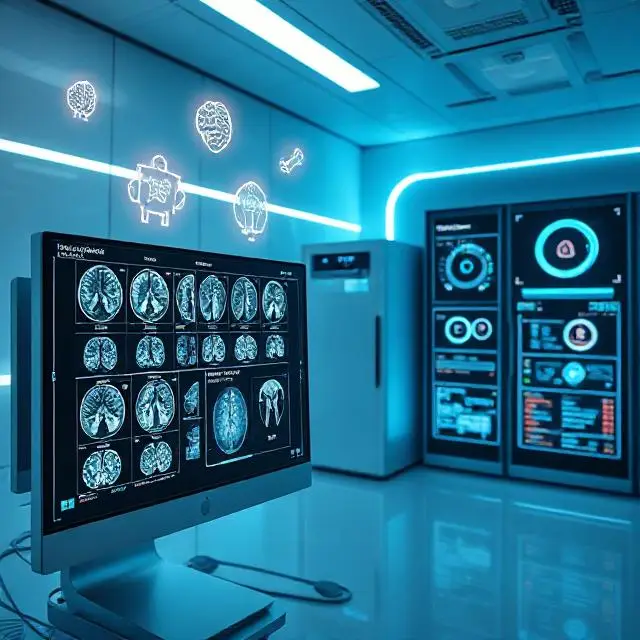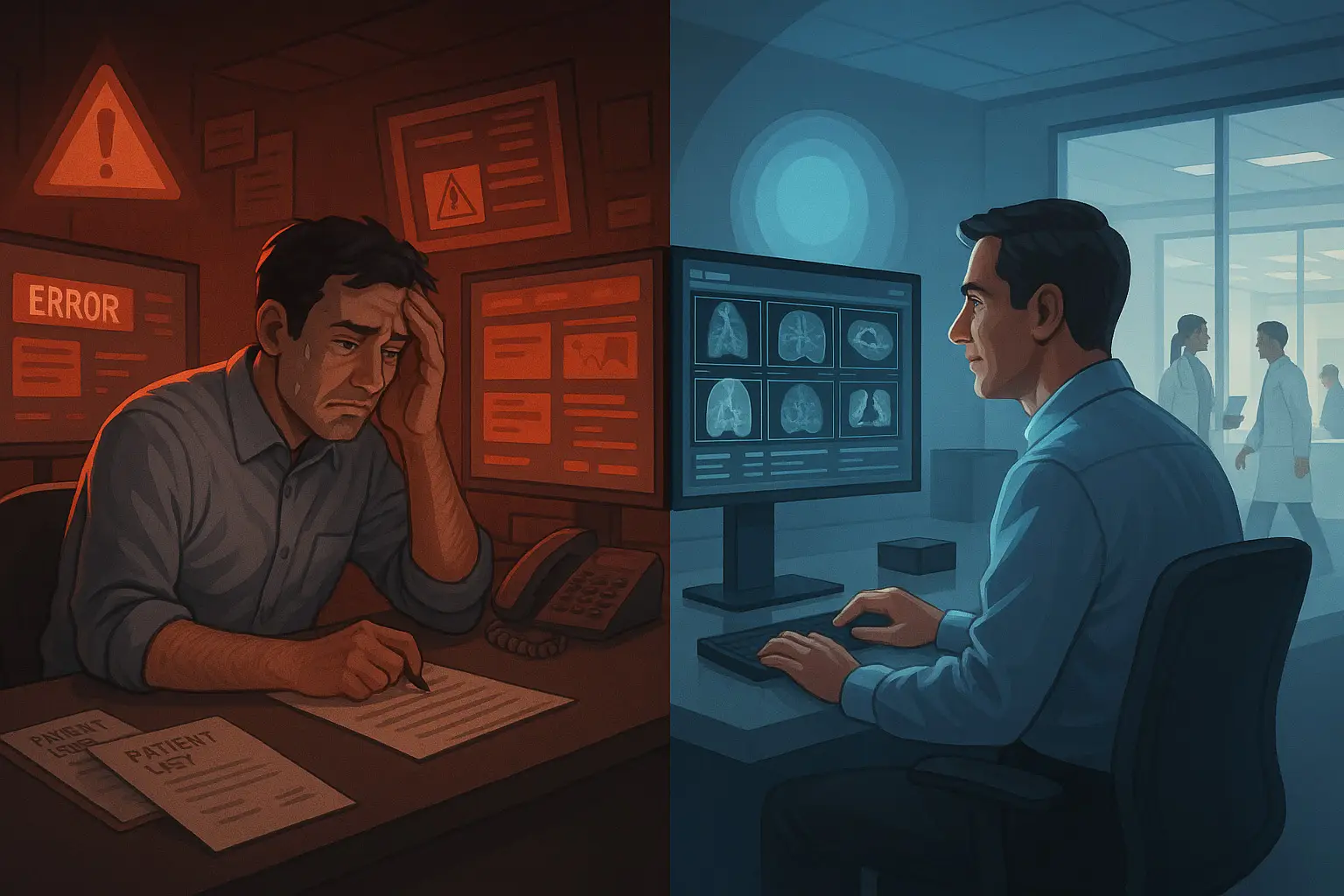Picture Archiving and Communications Systems (PACS) have been around for decades, and the market has become saturated with vendors and solutions. Experts have been writing about the benefits and functionality a PACS should provide and yet, despite this, many vendors still fall short of providing the needed functionality to improve the radiology workflow. They continue to ignore the core issues that PACS was designed to eliminate, in some cases exasperating the issues. Here is Enlitic’s take on what to consider when choosing a PACS and how Enlitic can ensure you get the most for your dollar, but with a twist – we don’t believe there are any PACS that can accomplish this without our help!
What are the best PACS Systems?
Some key components of a PACS that are generally considered important include: image acquisition, image storage, image viewing, image analysis, integration, and security.
Let’s break each of these aspects down so that you have information to help make the best PACS system decision.
How does the PACS ingest medical images from different imaging modalities and ensure their quality and consistency?
PACS ingests the data coming from the modality directly as it was acquired, except for when a QC station is present to split and merge patient data, adjust patient information. Otherwise, the series and study descriptions are untouched, data may be missing or inaccurate. Image routing is an important aspect of the reading workflow and often requires manual intervention. Descriptions may not be clinically relevant or meaningless to anyone reading the exam, making reporting more difficult than it needs to be. These processes often go wrong causing delays and wasted resources.
A great PACS should be able to analyze the studies and apply some degree of data governance or data standardization to the studies prior to any reporting to improve the workflows and efficiencies of the different stakeholders. It should be able to use this standardization to route data to a nighthawk service, orchestrate studies to assigned worklists and ensure that data gets to where it needs to be based on consistent routing rules. And it should all be done automatically.
How does the PACS store and manage large volumes of medical images efficiently and securely, and ensure their accessibility and integrity over time?
There are different technologies to store and manage medical image data. The selection and implementation depends on volume, capacity, security needs and compliance requirements. The available options include:
- Storage architecture today is a discussion about cloud vs. on premise vs. hybrid models which further dictates scalability and redundancy as well as predictability of costs.
- Data compression techniques such as lossless or lossy compression to reduce the size of image files, allowing for more efficient storage and transmission of images.
- Data backup and recovery ensures that images can be recovered in the event of data loss or corruption.
- Data encryption is used to secure images while in transit and at rest, ensuring that images are only accessible to authorized users.
- Data access controls to restrict image access to authorized users, ensuring that images are protected from unauthorized access or use.
- Lifecycle management of images ensures that images are stored for the required time and deleted securely when no longer needed.
Managing the large volume of data also impacts how your PACS system pulls back prior studies, displays those for the radiologist and ensures the correct studies are pulled back for comparison. Changing PACS vendors usually comes with a data migration and that adds a level of complexity that is impacted by the quality of the data. Vendor Neutral Archives will argue that data is stored in a standard format but that is limited to the DICOM structure, not the study descriptions and the actual content associated with a patient. Tag morphing only applies on demand, not permanently storing those changes rendering historical data inconsistent and difficult to leverage.
A great PACS will have migration tools that will apply a data governance standard to the study and series descriptions so that current and prior data is consistent and meaningful. Data becomes easily searchable and can be leveraged for research and data monetization strategies. The historical studies as well as the current studies will be more valuable for all stakeholders.
How does the PACS enable access and viewability of medical images from different locations and devices, and provide advanced visualization tools?
A PACS may assign studies to workstations or physicians worklists based on the workflows dictated by the organization. PACS may also provide advanced visualization tools such as 3D rendering, multi-planar reconstruction, volume rendering or Artificial Analysis to help visualization of complex anatomical structures and better understand the relationships between different structures. Getting data to these locations is a function of the PACS and should not require complex rules to route the data correctly, however these rules are entirely dependent on the quality of the data they are given.
Hanging protocols are an important part of being able to efficiently report on studies coming from a PACS. They are set up to allow for a consistent presentation of the studies in the way the radiologist prefers. These display protocols should continue to work after upgrades to either the PACS or the modalities providing the data. Hanging protocols are a widely known area of frustration and yet it is also widely accepted that protocols generally don’t work well.
A great PACS should ensure that there is consistency in the data quality and that images are sent where they need to be, displayed as expected and with minimal interaction from PACS Administrators. Similarly the protocols should work consistently without needing the manual intervention of radiologists or PACS Administrators.
How does PACS integrate with other healthcare information systems such as electronic health records (EHRs), radiology information systems (RISs), and hospital information systems (HISs) to ensure seamless exchange of patient data and streamline clinical workflows?
The PACS system sits in the middle of all the healthcare information systems and uses standards such as HL7, FHIR and DICOM to communicate with other healthcare systems. The PACS receives orders and patient information from the electronic medical record (EMR), creates the DICOM work list, and then receives the studies once acquired. Once a radiologist completes the report, the information can get pushed back to the EMR and information systems within the enterprise.
Some PACS systems were designed to be a little more flexible to follow the standards as they were intended. Some systems are a little more closed, integrating poorly and don’t share information easily to other systems. This motivates facilities to integrate a vender neutral archive (VNA) to store data in a standard format and facilitate easier migration of data.
A great PACS will ensure that data is able to be shared with consistently described content that provides other systems with data that can be utilized. The data should be easily searchable, tied to clinically relevant information and regardless of when acquired, the data should be uniform.
How does PACS ensure the confidentiality, integrity, and availability of patient data stored in the system, and comply with healthcare data protection regulations?
Patient data stored in the system and must comply with healthcare data protection regulations, the PACS must follow several security measures:
- Access to patient data is restricted to authorized personnel only. Role-based access controls ensure that only those who need to view or modify patient data have the necessary permissions.
- Patient data stored in the PACS is encrypted both during transmission and storage.
- There must be an audit trail of all activities related to patient data, including who accessed it, when it was accessed, and what changes were made.
- Each PACS has backup and recovery mechanisms in place to ensure that patient data is not lost in case of a disaster or system failure.
- The system follows strict guidelines for data access, storage, and sharing to ensure patient privacy and data protection to comply with healthcare data protection regulations.
A great PACS will also provide the ability to anonymize data while maintaining the clinically relevant data. Many PACS will delete any information based on the DICOM field, effectively removing the valuable data, and rendering the information less useful. Additionally, pixel data should also be anonymized and still maintain the high level of data quality needed.
Conclusion
Today’s PACS have advanced far from the early days, but still fall short in many areas where automation and artificial intelligence can play a role. Utilizing tools focused on managing the data better will help facilities get the biggest ROI out of their PACS while delivering to the stakeholders the expected satisfaction that PACS should bring. Enlitic has developed the data management tools that can supplement the work your PACS should be doing, even if you aren’t looking to change systems today. Get the most out of your PACS by adding simple AI powered data management tools.
Learn more about Enlitic’s ENDEX™








